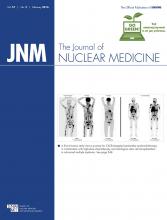Abstract
Acetylcholinesterase and butyrylcholinesterase accumulate with brain β-amyloid (Aβ) plaques in Alzheimer disease (AD). The overall activity of acetylcholinesterase is found to decline in AD, whereas butyrylcholinesterase has been found to either increase or remain the same. Although some cognitively normal older adults also have Aβ plaques within the brain, cholinesterase-associated plaques are generally less abundant in such individuals. Thus, brain imaging of cholinesterase activity associated with Aβ plaques has the potential to distinguish AD from cognitively normal older adults, with or without Aβ accumulation, during life. Current Aβ imaging agents are not able to provide this distinction. To address this unmet need, synthesis and evaluation of a cholinesterase-binding ligand, phenyl 4-123I-iodophenylcarbamate (123I-PIP), is described. Methods: Phenyl 4-iodophenylcarbamate was synthesized and evaluated for binding potency toward acetylcholinesterase and butyrylcholinesterase using enzyme kinetic analysis. This compound was subsequently rapidly radiolabeled with 123I and purified by high-performance liquid chromatography. Autoradiographic analyses were performed with 123I-PIP using postmortem orbitofrontal cortex from cognitively normal and AD human brains. Comparisons were made with an Aβ imaging agent, 2-(4′-dimethylaminophenyl)-6-123I-iodo-imidazo[1,2-a]pyridine (123I-IMPY), in adjacent brain sections. Tissues were also stained for Aβ and cholinesterase activity to visualize Aβ plaque load for comparison with radioligand uptake. Results: Synthesized and purified PIP exhibited binding to cholinesterases. 123I was successfully incorporated into this ligand. 123I-PIP autoradiography with human tissue revealed accumulation of radioactivity only in AD brain tissues in which Aβ plaques had cholinesterase activity. 123I-IMPY accumulated in brain tissues with Aβ plaques from both AD and cognitively normal individuals. Conclusion: Radiolabeled ligands specific for cholinesterases have potential for use in neuroimaging AD plaques during life. The compound herein described, 123I-PIP, can detect cholinesterases associated with Aβ plaques and can distinguish AD brain tissues from those of cognitively normal older adults with Aβ plaques. Imaging cholinesterase activity associated with Aβ plaques in the living brain may contribute to the definitive diagnosis of AD during life.
- Alzheimer's disease
- acetylcholinesterase
- autoradiography
- butyrylcholinesterase
- carbamate
- single photon emission computed tomography
Footnotes
Published online Nov. 5, 2015.
- © 2016 by the Society of Nuclear Medicine and Molecular Imaging, Inc.







